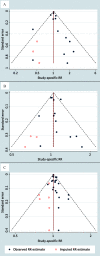Breast Cancer Risk in Association with Atmospheric Pollution Exposure: A Meta-Analysis of Effect Estimates Followed by a Health Impact Assessment
- PMID: 34038220
- PMCID: PMC8153692
- DOI: 10.1289/EHP8419
Breast Cancer Risk in Association with Atmospheric Pollution Exposure: A Meta-Analysis of Effect Estimates Followed by a Health Impact Assessment
Abstract
Background: The epidemiological literature of associations between atmospheric pollutant exposure and breast cancer incidence has recently strongly evolved.
Objectives: We aimed to perform a) a meta-analysis of studies considering this relationship, correcting for publication bias and taking menopausal status and cancer hormone responsiveness into account; and b) for the pollutants most likely to affect breast cancer, an assessment of the corresponding number of attributable cases in France and of the related economic costs.
Methods: We conducted a literature review and random-effects meta-analyses of epidemiological studies examining the association of fine particulate matter with aerodynamic diameter less than or equal to (), particulate matter with aerodynamic diameter less than or equal to 10 μm (), and long-term exposure with breast cancer incidence; additional analyses were stratified on menopausal status and on tumor hormone responsiveness status. The resulting dose-response functions were combined with modeled atmospheric pollutant exposures in 2013 for France, cancer treatments costs, lost productivity, and years of life lost, to estimate the number of breast cancers attributable to atmospheric pollution and related economic costs in France.
Results: The review identified 32, 27, and 36 effect estimates for , , and , respectively. The meta-analytical relative risk estimates of breast cancer corrected for publication bias were 1.006 [95% confidence interval (CI): 0.941, 1.076], 1.047 (95% CI: 0.984, 1.113), and 1.023 (95% CI: 1.005, 1.041), respectively. estimated effects appeared higher in premenopausal than in postmenopausal women and higher for hormone responsive positive () than negative () breast cancers. Assuming a causal effect of , we estimated that 1,677 (95% CI: 374, 2,914) new breast cancer cases were attributable to annually in France, or 3.15% (95% CI: 0.70, 5.48) of the incident cases. The corresponding tangible and intangible costs were estimated to be € (low, high: 570, 1,080) per year.
Conclusion: These findings suggest that decreasing long-term exposure or correlated air pollutant exposures could lower breast cancer risk. https://doi.org/10.1289/EHP8419.
Figures





Comment in
-
Invited Perspective: Air Pollution and Breast Cancer Risk: Current State of the Evidence and Next Steps.Environ Health Perspect. 2021 May;129(5):51302. doi: 10.1289/EHP9466. Epub 2021 May 26. Environ Health Perspect. 2021. PMID: 34038219 Free PMC article. No abstract available.
References
-
- Andersen ZJ, Ravnskjær L, Andersen KK, Loft S, Brandt J, Becker T, et al. . 2017a. Long-term exposure to fine particulate matter and breast cancer incidence in the danish nurse cohort study. Cancer Epidemiol Biomarkers Prev 26(3):428–430, PMID: 27913396, 10.1158/1055-9965.EPI-16-0578. - DOI - PubMed
-
- Andersen ZJ, Stafoggia M, Weinmayr G, Pedersen M, Galassi C, Jørgensen JT, et al. . 2017b. Long-Term exposure to ambient air pollution and incidence of postmenopausal breast cancer in 15 European cohorts within the ESCAPE project. Environ Health Perspect 125(10):107005, PMID: 29033383, 10.1289/EHP1742. - DOI - PMC - PubMed
Publication types
MeSH terms
LinkOut - more resources
Full Text Sources
Other Literature Sources
Medical
Research Materials

